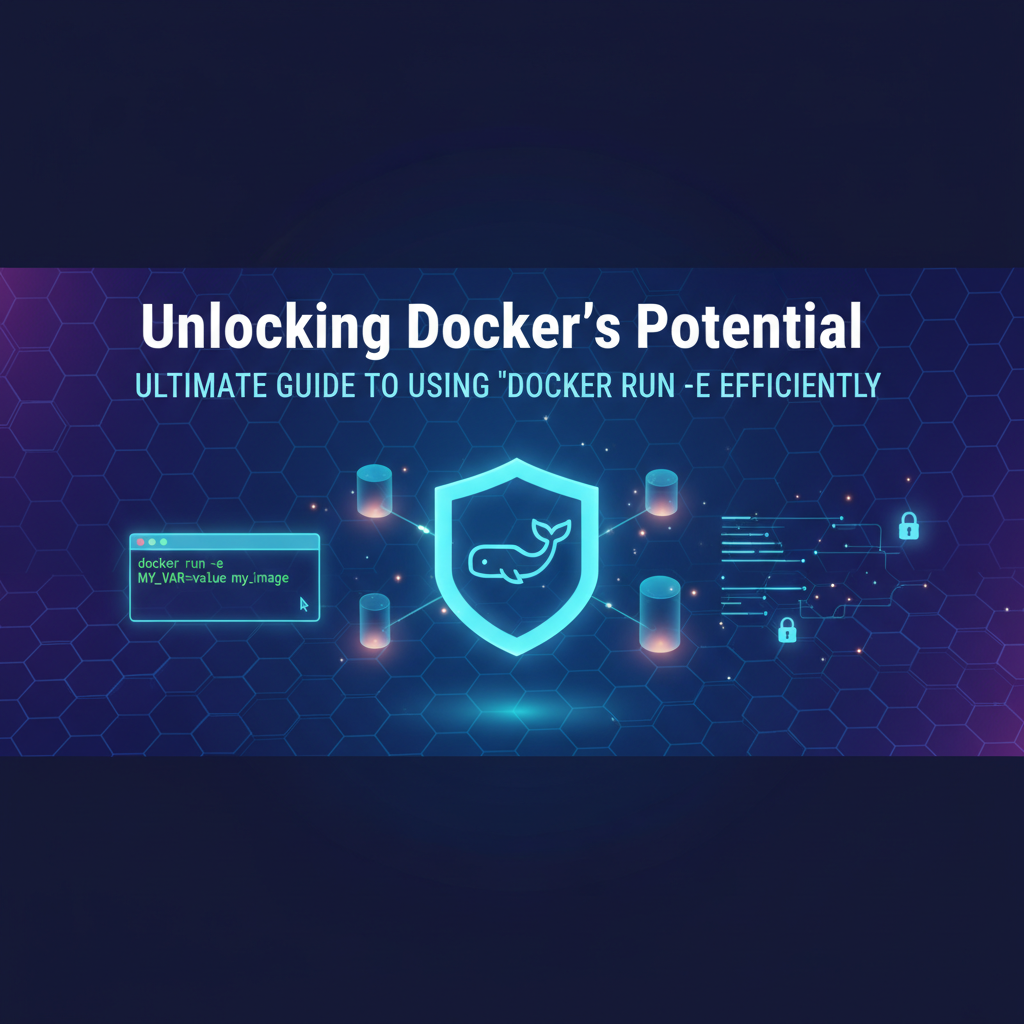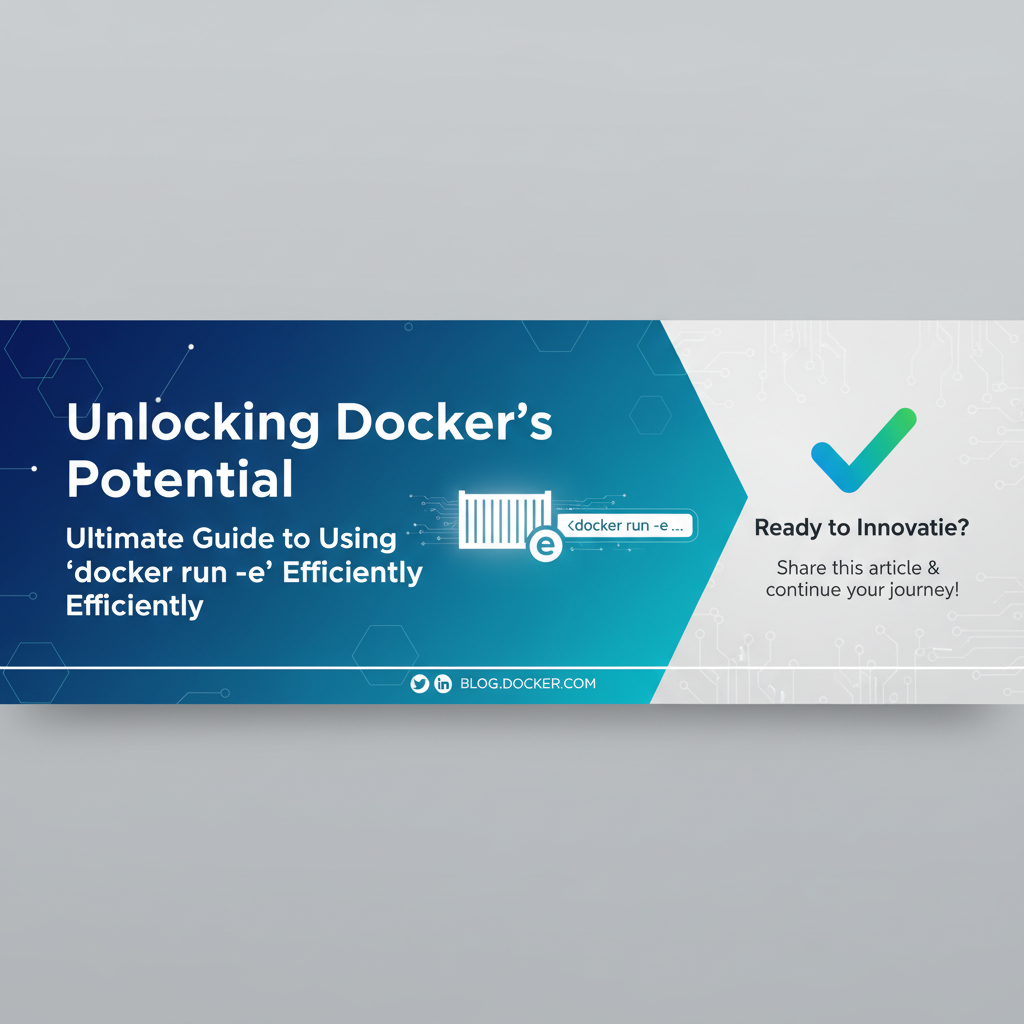Unlocking Docker's Potential: Ultimate Guide to Using `docker run -e` Efficiently

Introduction
Docker has revolutionized the way we deploy applications, allowing developers to create, ship, and run applications in containers. One of the most powerful commands in Docker is docker run, which is used to run a container. Among its many options, -e stands out for its ability to set environment variables. This guide will delve into the intricacies of using docker run -e to unlock the full potential of Docker.
Understanding Docker Run -e
The docker run -e command is used to set environment variables for a Docker container. Environment variables are used to pass information to a container at runtime. They can be used to configure applications, set security parameters, or provide configuration options that can be changed without modifying the container's image.
Syntax
The syntax for setting environment variables with docker run -e is straightforward:
docker run -e NAME=VALUE image_name
Here, NAME is the name of the environment variable, and VALUE is the value you want to assign to it.
Benefits of Using Environment Variables
- Configurability: Environment variables allow you to configure your containers at runtime, which is especially useful for different deployment environments (development, staging, production).
- Security: By setting environment variables, you can avoid hardcoding sensitive information like passwords or API keys into your Dockerfiles.
- Flexibility: You can dynamically change environment variables without rebuilding your container image, which is beneficial for continuous integration and deployment workflows.
Common Use Cases
- Database Credentials: Setting environment variables for database credentials ensures that sensitive information is not stored in the container image.
- API Keys: Environment variables are ideal for storing API keys, as they can be easily changed without rebuilding the container.
- Configuration Parameters: Environment variables can be used to configure application settings like timeout values or logging levels.
Examples
Example 1: Setting Database Credentials
docker run -e DB_HOST=localhost -e DB_USER=root -e DB_PASS=s3cr3t mydatabase:latest
This command runs a database container with environment variables for the database host, user, and password.
Example 2: Using API Keys
docker run -e API_KEY=12345abcde myapp:latest
This command runs an application container with an API key set as an environment variable.
APIPark is a high-performance AI gateway that allows you to securely access the most comprehensive LLM APIs globally on the APIPark platform, including OpenAI, Anthropic, Mistral, Llama2, Google Gemini, and more.Try APIPark now! 👇👇👇
Best Practices
- Keep It Secure: Never store sensitive information in your Dockerfiles or Docker images. Use environment variables for such data.
- Use Descriptive Names: Choose clear and descriptive names for your environment variables to make them easier to understand.
- Avoid Overriding Built-in Variables: Some environment variables are used by Docker internally. Avoid overriding these variables unless you are certain of the implications.
Troubleshooting
- Incorrect Variable Name: Ensure that the variable name is spelled correctly and matches the expected format.
- Incorrect Value: Verify that the value assigned to the environment variable is correct and in the expected format.
- Permission Issues: Ensure that the user running the
docker runcommand has the necessary permissions to set environment variables.
Advanced Usage: Using -e with docker run -p
Combining docker run -e with -p allows you to map environment variables to ports on the host machine. This is particularly useful for exposing services running inside the container.
Example
docker run -e PORT=8080 -p 8080:8080 mywebapp:latest
This command runs a web application container and maps the PORT environment variable to port 8080 on the host machine.
The Role of APIPark in Docker Deployment
When deploying applications using Docker, managing environment variables can become complex, especially as the number of containers grows. This is where APIPark comes into play. APIPark, an open-source AI gateway and API management platform, provides a centralized solution for managing environment variables and other configurations across multiple containers.
APIPark and Docker Run -e
APIPark can be integrated with Docker to manage environment variables at scale. By using APIPark, you can:
- Centralize Configuration: Store and manage environment variables in a centralized location, making it easier to manage configurations across multiple containers.
- Automate Deployment: Automate the deployment process by linking APIPark with your CI/CD pipeline to ensure that environment variables are set correctly in each container.
- Enhance Security: Use APIPark's features to ensure that sensitive information is securely stored and managed.
Conclusion
The docker run -e command is a powerful tool for configuring Docker containers. By understanding how to use it effectively, you can unlock the full potential of Docker and deploy applications more efficiently. Remember to follow best practices, keep sensitive information secure, and leverage tools like APIPark to manage configurations at scale.
Frequently Asked Questions (FAQ)
Q1: What is the difference between docker run -e and docker exec? A1: docker run -e sets environment variables for a new container, while docker exec allows you to run a command inside a running container with the current environment. They serve different purposes and are used at different stages of container management.
Q2: Can I change an environment variable after a container has started? A2: No, you cannot change an environment variable for a running container using docker run -e. However, you can use docker exec to run a command inside the container with a new environment variable.
Q3: How can I ensure that my environment variables are secure? A3: To ensure security, never store sensitive information in your Docker images or containers. Use environment variables for such data and consider using tools like APIPark to manage and encrypt sensitive configurations.
Q4: Can I use environment variables with non-alphanumeric characters? A4: Yes, you can use environment variables with non-alphanumeric characters. However, it is recommended to use descriptive names and avoid special characters that might cause issues.
Q5: What is the best practice for managing environment variables in a CI/CD pipeline? A5: The best practice is to store environment variables in a secure, centralized location and reference them in your CI/CD pipeline scripts. This ensures consistency and reduces the risk of sensitive information being exposed.
🚀You can securely and efficiently call the OpenAI API on APIPark in just two steps:
Step 1: Deploy the APIPark AI gateway in 5 minutes.
APIPark is developed based on Golang, offering strong product performance and low development and maintenance costs. You can deploy APIPark with a single command line.
curl -sSO https://download.apipark.com/install/quick-start.sh; bash quick-start.sh

In my experience, you can see the successful deployment interface within 5 to 10 minutes. Then, you can log in to APIPark using your account.

Step 2: Call the OpenAI API.



